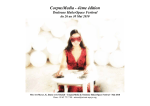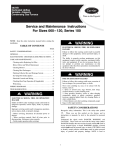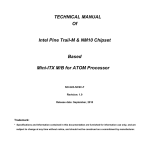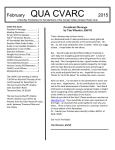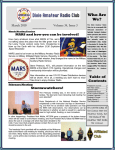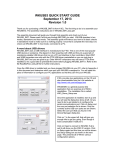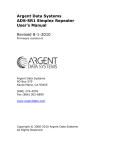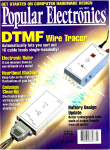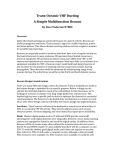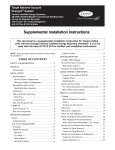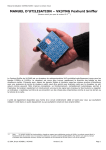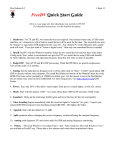Download March - Gloucester County Amateur Radio Club
Transcript
Volume 55 Issue #03 Celebrating Our 55th Year March 2014 Happy Birthday GCARC! Congratulations to you, our members, for making this the active club it is today! From monthly club meetings and guest speaker programs, to emergency preparedness and public service, to support, to ham radio license testing, and much more, it’s fun to socialize and hang out at club events like field day, fox hunts, earth-moon-earth radio attempts and contesting out at the clubhouse, summer picnic, and winter holiday party with fellow radio heads as an active member of a much larger international ham radio operator fraternity. If you’re reading this, and are not already a member, why not consider joining us? Speaking of birthdays, did you hear? The ARRL turns 100 this year, and our club is going to be part of that celebration! Throughout the year, W1AW, the ARRL’s HQ operator’s club, is operating portable in each state and most US territories. Our club has been offered an unique opportunity to represent New Jersey by operating a W1AW/2 station in August of this year. At the February club meeting, we discussed this, and enthusiastically voted yes to participate from our new clubhouse! Since then, I have been in contact with our state’s W1AW coordinator, and we’re good to go! Can you imagine being on the receiving end of one of those W1AW pile-ups? Look for more details on how you can participate later this year. As for club meetings, “Pedestrian Mobile” was the theme of our February club meeting. Worldrecognized /PM specialist and author Ed Breneiser (WA3WSJ) shared his exploits and expertise with us as guest speaker. Very cool. Clever tricks he had for that water-bottle battery, and for using a piece of a metal tape measure to keep the backpack antenna from snapping on trees. This month, the sky’s not even the limit. You’ll know what I’m talking about when I see you at this month’s meeting. Been on the radio recently? I’ve heard some Technician class licensees talking about some lucky propagation conditions in both the digital and sideband portions of 10 meters. Were you one of them? While you were there, did you see any special event stations from Russia during the Sochi Winter Olympics on your PSK waterfall? How about any Antarctic week special event stations? I’ve still had no luck getting any Antarctica station in my log. How about you? It boggles the mind how there are sane people who are willingly preparing to stay down there as they head into winter. Did you not get enough of it up here? Whatever your interest, there seems to be a little something in this hobby for everyone. Glad to have you as part of our Gloucester County Amateur Radio Club. If you like what you see, consider inviting a friend to one of our events or club meetings. Respectfully, Jim Wright, N2GXJ 1 Down Jersey DXing By Bill Grim, W0MHK HF radio conditions have held up nicely for DX during the last few weeks. This should confirm that we are indeed in the midst of a second "peak" in the Sunspot Cycle 24. This is good news for the DX'er especially since this current cycle has been far less than spectacular. Let's hope that a sustained high solar flux reading will reign during the late spring and summer months to perk up prospects on 6 Meters after the poor showing Down Jersey last VHF season. Working the FT5ZM Amsterdam Island DXpedition was probably not easy if you were at all successful in reaching them. The rarity of its very distant geography made for limited openings on the bands and often weak or "no copy" signals. But the consistency of the readability on a number of bands (at least from this QTH Down Jersey) was rather amazing! There were numerous openings on 10 meters in the mornings and to a lesser degree on 12 Meters. Surprisingly, 15 Meters ended up being one of the toughest bands to work them on from our neck of the woods. Europe had a great advantage due to longer openings and shorter distances than North America. The Europeans were quite a wall to overcome on many bands. "ONLY NA" helped many get through from stateside. In looking at the DXpeditions final QSO total of 170,000+, Europe did very well in working FT5ZM compared to North America, especially above 20 Meters. Unfortunately, it must be mentioned that intentional jamming was too often a problem with this DXpedition. Bad manners, comments, key down signals all cut into the efficiency of the operation and the ability to work as many stations as possible. Tuning up on the zero beat frequency of the FT5ZM was especially bad. DO NOT tune up on top of a station you wish to work! Use a dummy load or move to a non-busy frequency (QRL? or "Is the frequency is use?" is proper etiquette) before tuning up. Another common error (yes, I will plead guilty to this one at times) is forgetting to check if you are actually in "Split Frequency" mode on your rig. It is an especially EASY way to QRM the DX station unintentionally. It often happens during the excitement of first finding and calling the DX station. Make an extra mental check that you are in the right transmit SPLIT mode and check your transceiver's visual indication to be sure you are!!!! This is a problem for the seasoned DX'er and the beginner! Finally, having the "luxury" of checking Club Log to see if you were in FT5ZM's log before they left the island, can't be lauded enough. It confirms your efforts and limits the need to re-QSO the DX station on the same band and mode already worked. All in all, you will probably not experience a better planned and executed DX effort than Amsterdam Island. Congrats to the team and local kudos to GCARC DX'er W2YC! Dave worked the FT5 on five additional bands to sew up having this DXCC entity on a total of NINE BANDS! Am surely looking forward to seeing the FT5ZM story being told on an upcoming CD! March can be a strange month for propagation with winter and spring radio characteristics alternating through the month. My 10 DX choices for the "lion in/lamb out" month include a number of semi-rare DX tidbits to add to your DXCC totals. Keep your ears open for some very nice Rarity 3's and 4's: (Continued on page 3) 2 (Continued from page 2) CALL DATES HIGHLIGHTS DIFFICULTY (5=MOST RARE) 9J2T 02/28 - 03/17 Italian Team/All Bands & Modes 2 Zambia VK9X 03/01 - 03/11 80-10M/SB,CW,PSK31 4 Christmas Island PJ6 03/04 - 03/19 HF 1 Saba Island S0 03/10 - 03/20 40-10M/SSB 3 West Sahara 4S7 03/10 - 03/23 4 Stations/160-6M/Many Modes 3 Sri Lanka VK9NF 03/15 - 03/22 Mainly HF Digital 3 Norfolk Island TX6G 03/20 - 04/01 3 Stations/Big UK Effort 2 Austral Island ZL7AAA 03/20 - 04/01 HF/CW,SB,RTTY 3 Chatham Island VU4K 03/23 - 03/30 HF/SSB,RTTY 4 Andaman Island VK9MT 03/28 - 04/09 Multi-Station/10 Operators Many Modes/Bands 4 Mellish Reef ENTITY Credits : NG3K ADXO Programs! Get Your Programs! By Cory Sickles, WA3UVV Thanks again to everyone who came out to meet Ed Breneiser, WA3WSJ, at the February meeting. In spite of the adverse weather, we still had about one-third of our membership in attendance. I trust everyone enjoyed Ed’s presentation and the copies of his e-books, which he graciously handed out – free of charge. This month, we’re going to be treated to a presentation by one of our own – John Zaruba, Jr, K2ZA. John is experienced as a builder, author, D-STAR Sherpa and in-thefield portable operator – plus many more specialties, including his significant role in EMCOMM. John will be talking about satellite communications, both on an entry level and what more-advanced operations include. If you’ve ever given thought to using your handheld radio to communicate over a larger area through a satellite or the ISS – even to one of the astronauts living there – then be sure to be in attendance. On deck for April, we have John Dilks, K2TQN, author of QST’s “Vintage Radio” column. John has a great presentation in store to take us back into history, plus show us some ways we can relive that older tech, today. What’s coming up in May and beyond? Stay tuned! 3 The H-Double-Bay Antenna Revisited By Keith Waltman, W2ERP “All you need is a simple wire antenna that you can build for a few dollars,” is what the man behind me said at the Shelby Hamfest in 2005. I was carrying a six meter loop to the car and he wanted to talk about his favorite antenna. He was Ron Bailey, AA4S, formerly of Haddonfield, NJ. Ron seemed like a regular guy, excited about ham radio and especially about the antenna he exhibited at the Southeast VHF Conference. However, Ron had a very dark side. (see foot note) The H-Double-Bay was first developed for use on 17 meters and was featured in CQ magazine. (CQ Archives September 1995) For the new band, it featured gain in two directions and was inexpensive to build. CQ Magazine archives September 1995 The antenna is great for six meters but it gets better as the frequency goes up. Here are some sample antennas and , the H-Double-Bay page from The Southern VHF Society: https://sites.google.com/site/wvfisher/2007southeastvhfconference There is an easy calculator you can use to build your own included on the site. Image from original CQ Magazine article In its purest form, the antenna is formed like the letter “H” with the top center and closed. The bottom is cut in the center to form the feed point. It is a 50 ohm antenna. The H-Double-Bay is easily adaptable to VHF and up frequencies. The first one I made for six meters was built with half-inch PVC horizontal sections. The one I just built this fall uses small fiberglass driveway markers for the horizontal sections. ( http://www.sportsbybrooks.com/youth-baseball-coach-was-classic-pedophile-23495) Welcome New Club Member: William Jones, KD2FHM, who holds a General class license and lives in Mantua, NJ. Welcome Back Club Member: Matt Wilson, K2MFW, who holds a General class license and lives in Millville, NJ. We are glad to have you as members of the Club and hope to see you regularly at Club functions and meetings. 4 Radio Direction Finding FoxHunt - March 9, 2014 By Jim Wright, N2GXJ Oh yea! Dust off your handheld and get ready to hop in the car for some RDF fun here in Gloucester County. What’s a ‘foxhunt’ you ask? Glad you did! It’s nothing but a family friendly driving, navigating, and radio direction finding skills activity all in one. Just check out the links from previous GCARC Fox Hunts from the tab on our website to learn more. Has it been a while since you joined us on a foxhunt? Well, call a fellow club member and partner up to give this one a go. Never tried a radio foxhunt before? Well, call me, and we’ll get you teamed up to ride along for some first time fun! We’re giving you plenty of advanced notice on this one, so reserve the date! Date: Sunday March 9, Time: 1-3pm. What better way to celebrate the leap to Daylight Savings Time on that day than with a “Spring has Sprung” foxhunt! Tune in at 1pm on our 2M repeater frequency to check-in so we know who is hunting, and then get instructions on how the find the fox. From that point on, use signal strength, or whatever technique suits you best to find the hidden transmitter. If any teams are still searching after an hour, we’ll start giving out better clues. If any are still hunting after an hour and a half, we’ll walk you in so that we can all meet up at the transmitter’s location to exchange hunt stories and a good laugh. Happy hunting! Restoration Corner By Vinnie Sallustio, N4NYY Many of you know that I dabble in restorations. I have recently started to dabble in transistor radio restoration. If any of you have an old Late 1950's, 1960's or early 1970's transistor (pocket or tabletop), working or non-working, that was headed to the scrap heap, DO NOT THROW IT OUT! Just email me as I might be interested. yankees_1996 <at> hotmail <dot> com Members in jeopardy, members in good standing By Jim Wright, N2GXJ The advantages of membership in the Gloucester County Amateur Radio Club are many, and at only $20, it’s a bargain. If you have already renewed your dues for this year, we thank you. If you have not renewed already, please do so in person at the March meeting, or via postal mail to our P.O. box promptly. You’re running out of time. Don’t become a member in jeopardy. Do be a member in good standing. 5 Origin of the word "HAM" By Ray Martin, W2RM Have you ever wondered why we radio amateurs are called "hams"? well, it goes something like this. The word was applied in 1908 and represented the call letters of one of the first amateur wireless stations operated by some members of the Harvard Radio Club. They were Albert Hyman, Bob Almy, and Peggy Murray. At first they called their station Hyman-Almy-Murray. Tapping out such a long name in code soon called for a revision, and they changed it to Hy-Al-Mu, using the first two letters of each name. Early in 1909 some confusion resulted between signals from Hyalmu and the Mexican ship named Myalmo, so they decided to use only the first letter of each name and identified their station as HAM. In the early pioneer and unregulated days of radio, amateur operators picked their own frequencies and call letters. Then, as now, some amateurs had better signals than some commercial stations. The resulting interference finally came to the attention of Congressional Committees in Washington, and they gave much thought to proposed legislation designed to limit amateur activity. In 1911, Albert Hyman chose the controversial Wireless Regulations Bill as the topic of his thesis at Harvard. His instructor insisted that a copy be sent to Senator David Walsh, a member of the committee hearing the bill. The senator was so impressed that he sent for Mr. Hyman to appear before the committee. Hyman was put on the stand and described how the little amateur station, HAM, was built, and he told the committee that if the bill went through, they would have to close the station because they could not afford the license fees and other requirements to set up. The station HAM became a symbol of other amateur stations in the country that the commercial stations did not want around. when the bill got to the floor of the Congress, other speakers talked about HAM. That's how it all started. You can find the whole story in the Congressional Record. Nationwide publicity identified the station HAM with amateurs. From that time to this, every amateur is a "HAM." 2013 Licensing Statistics (From the ARRL Winter 2014 Radio Waves Newsletter) The following report of FCC licenses issued is supplied by Maria Somma, AB1FM, ARRL VEC Manager. Somma notes that new licensees increased by 7% over 2012 (28,886 in 2013 versus 27,082 in 2012). Licensed US Amateur totals as of December 31, 2013 were at a new high of 717,201, a 1% increase over the 2012 year end total of 709,575. New and Upgraded FCC licenses issued by year FCC License Activity 2011 2012 2013 Technician 21,316 23,974 25,621 General 9,667 10,132 9,567 Extra 3,426 3,259 3,023 Total Issued 34,409 37,365 38,211 6 My HAM Shack By Curt Myers, WA2JSG I enjoy working straight key CW (all bands) with the Straight Key Century Club www.skccgroup.com, and the NAQCC http://naqcc.info/ . Great bunch of gals and guys there. Anyone going to Dayton this year, look for me at our SKCC booth. Most of my radios are Icoms (IC703, IC-7000, and IC-7200). Only HF antenna is a Butternut HF9V Vertical (elevated), and gets me around the globe with band openings, running 5w to 75w. Curt WA2JSG Salem County Community Outreach Opportunities By Cory Sickles, WA3UVV Many of the members of this organization are wonderful at reaching out to help our communities and supporting special events. Overall, we probably get involved in more activities like this than many others. However, are we as involved as we could be? It’s well known that I have certain “pet projects” I’m enthusiastic about, such as Tour de Pitman and the MS-150. What about you? Is there some organization, event or activity you would like to see us support? If so, please make your desires known. The more things we are involved in that help our communities and allow us to demonstrate the kind of relevant public service we – and amateur radio – offer, the better it is for all concerned. 7 Review - Hamcrafters WKUSB-SMT USB Keyer Kit By Chris Heller, WK2W There was a time when interfacing your personal computer to send CW was a fairly simple thing to do. If you had an opto-isolator, a 2N2222 transistor, or even a small relay with a 5 VDC coil in your junk box, you could make up a nice little interface to key your radio from your COM port. With the gradual phaseout of the COM and printer ports on desktops and laptops, things are becoming more complicated. Most CW contesters (and even some casual operators) are switching over to USB devices for interfacing their PC’s to their radios. While they require a little more configuration to get them up and running, they tend to operate more reliably than COM-port interfaces. Since the COM port may not have been the first priority for a PC’s operating system, you may have been forced to wait a second or longer for the PC to send the message when you hit that F-key. This caused quite a bit if frustration, to say the least. Today’s PC’s run faster, USB devices are more responsive, and keyers sometimes include data buffers to ensure messages are sent reliably. Recently, Merrill Brown, WK2G and I were discussing options for something to use with his newer laptop. Merrill came across the www.hamcrafters.com (formerly K1EL.com) website, and found the WKUSB-SMT keyer kit. It seemed like a nice little keyer that did everything a USB keyer needed to do without a lot of needless extras. The price ($89) was pretty good, too. Merrill was kind enough to let me build the kit for him. As this keyer is based on SMT (surface-mount technology) devices, nearly all the parts are already soldered to the board. Building the kit requires soldering a few jacks and switches to the board, as well as connecting the speed potentiometer and the battery holder. After that, all that’s needed is a little mechanical assembly. The total time to assemble the kit, set up the software, and get it running was less than three hours – a nice little Sunday morning project. The keyer boasts dual CW and PTT outputs, a speed control, four internal memories, and a small internal speaker. It operates as a stand-alone iambic memory keyer if you install three AAA batteries, or you can power it from your PC over the USB cable. Installing the batteries is somewhat inconvenient as it requires removal of the four chassis screws. However, except for using the keyer in portable operation without a laptop, it’s unlikely that the batteries would be needed anyway. The kit also includes a CD with some nice configuration software and the assembly / user manual. Operation is simple. When you power on the keyer, it sends an “R” over the internal speaker. CW speed is adjustable with the speed control or through your contest or logging software. Customizing your CW preferences such as weight, ratio, min/max speed, and PTT lead-in time is very easy with the WKTOOLS application found on the CD. The keyer does not include a volume control for the internal speaker, but it’s quiet enough to easily fade into the background in nearly all situations. The sidetone frequency however, is software-adjustable. During initial testing, no delays or interruptions were noted in its response to message commands. Setup of the four non-volatile, internal memories was easy as well. Being the consummate CW operator, Merrill put the keyer to the ultimate test in the First Class CW Operators (FOC) contest. If there ever was a contest that requires a CW op’s best performance, this is it. Merrill was thrilled with the keyer’s performance, saying it operated flawlessly the entire weekend while running between 35 and 40 WPM. (Continued on page 9) 8 (Continued from page 8) Overall, the WKUSB-SMT from hamcrafters.com is a quality USB keyer and an easy-building kit. Project success is virtually guaranteed by the use of the pre-assembled and tested circuit board. The keyer operates very well and includes all the necessary software and information for trouble-free setup and operation. At $89, it’s also a good value compared to other USB keyers on the market. 9 VE test session, changing question pool By Jim Wright, N2GXJ Looking to get that first “Technician” class ticket? Looking to upgrade to “General”, or even to “Extra”? Please note that the question pools for each license class change every 4 years on a staggered basis. If you are studying now for a Technician Class license, be advised that the question pool will change after June 30 of this year. The General and Extra class question pools will be upgraded in 2015 and 2016, respectively. As part of our continuing commitment to the advancement of Amateur Radio, GCARC conducts FCC license exams on a regular basis. Our current testing location is at the Franklinville Library, meeting on the second Thursday of the month at 7pm. Contact our VEC liaison Gary Reed if you need more information. Walk-in test takers welcome. For copies of the current question pools (along with answers), and for more information about what to bring to a test, how to contact Gary if you have questions, and more, please see the “Get Your Ham Ticket” tab on the left side of our club’s website, w2mmd.org. Saying “Good Bye” to an Old Friend in the Skies By Cory Sickles, WA3UVV Earlier this year, the last DC-9 was retired from commercial passenger service, after a long and storied career getting many of us from city to city. Delta (Detouring Everyone Leisurely Through Atlanta) Airlines was the last carrier flying 9’s, until January 6th. It was almost half a century since they went into service in 1965, but even for an older aircraft, it had innovations that were still important today. The longer wing flaps and dynamic engines enabled the planes to use shorter runways at “secondary” airports. The T-tail and higher, rear mounted engines meant that ground crews could begin servicing the plane – and handle luggage – faster, without having to wait for the engines to spool down. Features like this opened air travel to more people, for less money and allowed us all to be connected that much more. The planes were the workhorse of many carriers, such as Allegheny (precursor to US Air, later US Airways) Airlines – which were rumored to use the orange roofs of Howard Johnsons’ as NAV markers. With nicknames like “Chuck Niner” and “Diesel 9” the planes were loved by seasoned pilots. Although dated by today’s digital technology, even with some updates over time, a close look at the cockpit ( www.hilmerby.com/dc9/cockpit.html ) reveals a wealth of analog gauges and controls – from a design long before anyone was saying “fly by wire”. Like an older tube rig or your first “four on the floor” car, there was a certain familiar comfort in being seated inside an old friend. As someone who logged hundreds of passenger hours in the ‘9’, they are missed – and really have been for some time. Along the same lines, the much bigger cousin – the DC-10 – will be likewise retired in the coming months. 10 Antenna Crossword Puzzle By Jim Wright, N2GXJ Bands not that great? Dreaming of a new antenna? Here’s an original antenna-related beam-shaped crossword puzzle my sister in law came up with. Enjoy! DOWN 1. Antenna constructed with a long radiating element placed perpendicular to the earth ACROSS 1. Official Magazine of the ARRL 2. Antenna that must be rotated to provide coverage in different directions 3. Antenna built with triangular elements 4. Antenna designed for use on two different Amateur Radio Bands 5. Antenna built with its elements in the shape of four-sided loops 6. One of a family of frequency-independent antenna 7. Of interest to traffic & contest operators who like to use 80- and 40- meter bands it makes complete coverage of a single band easy 8. Basic Antenna consisting of a length of wire or tubing opened and fed at the center 9. Most popular Antenna with one driven element and one or more additional elements Clubhouse By Jim Wright, N2GXJ Spring is in the air, and so is the smell of sawdust and paint out at our new clubhouse under renovation. Keep an eye out for emails concerning the next work party. With some luck, your help, and a break from mother nature, wouldn’t it be great if we could have a “grand opening” later this spring? Seven Samurai - When the mission called for the best → 11 GCARC’s Double Nickel By Cory Sickles, WA3UVV February almost got past us this year without noting that our club celebrates 55 years of ham radio fun and family in 2014. According to the Ancient Texts, as researched by Jeff Garth (and Art Strong before him), the first “official” meeting of the Club seems to have taken place in February of 1959. This was an era of cars with tail fins, doo-wop music playing from radios with essentially no bass line, long-distance calls that mostly involved operator assistance and bras that resembled ballistic missile nose cones. As color reception was rather expensive, television was a black and white world for most, offering 3 (maybe 4) stations to watch. Computers were huge and travels to the moon were still the stuff of science fiction. Nobody knew what a pocket calculator was, but anyone performing high-level math owned a slide-rule. As many high schools had hunting, target shooting or archery clubs, it was commonplace for students to bring guns and other weapons to school - yet no one freaked out and no one turned them on each other. (On the other hand, no one yet had the advanced technology to carry around a pocket-sized telephone that allows us to order products on a whim, share pictures of frowning cats and sickeningly sweet children in posed moments or sarcastically argue about politics and religion with complete strangers in a bi-polar fashion) From a technology standpoint, amateur radio was quite different than it is today. Activity on out VHF and UHF bands was mostly AM, with regenerative “rush box” receivers. AM still was the overwhelming mode on HF as well, with SSB making steady strides. While solid-state electronics was still in its infancy, the use of germanium diodes and transistors was increasing rapidly – especially for anything considered “portable”. But from a standpoint of camaraderie, mentoring and a willingness to work together to make things better for all concerned, attitudes are pretty much the same. The motivations that started this organization over half a century ago, have strengthened it and helped it grow with a positive attitude we still enjoy today. We are still blessed to have one of GCARC’s “Founding Fathers” with us today – Charlie Sketchley, K2PQD. If you haven’t talked to Charlie in a while or been out to brunch with him on Fridays at the Seven Stars Diner, why not pick up the phone and say “Hi!”, while thanking him for being one of the guys that formed our group and significantly guided it along the way. In honor of our 55th anniversary year, we could have a special event call. In 2009, we used W2MMD/50 at our Hamfest, in a quickly put together affair. This time around, I’m thinking we could put some serious effort into it – as an entire organization – and operate a special event at our new clubhouse and station, when we’re not so busy with the Hamfest. I’m looking into what needs to be done to get a special callsign to commemorate this milestone. If you think it’s a good idea to promote the Club in this way – especially as it’s the 100th anniversary of W1AW – then please share your thoughts and ideas on this. It will require a bit of work and creative effort, but it should be a fun time for all involved! 12 GCARC Repeaters Update By Jim Wright, N2GXJ The GCARC repeater committee is looking for additional club members technically inclined towards UHF/VHF debugging and repeater communications that are willing and able to help improve our current repeater operations. Please contact our Repeaters chairman direct if you think you can help out. Late last year, it was discovered that our 2 meter antenna coax jumper cable that connects the hardline to the antenna had been broken off, presumably by careless installers of cell phone equipment at the Pitman water tower location (see photo). We made a decision on the spot to get the 2 meter repeater back on the air as soon as possible. We did that by switching its hardline connection over to the cable that we had been using for our 442 repeater, at the expense of the 442 repeater being off air until the new cable could be ordered and installed. We have the cable now, but are just waiting on better weather to get it installed. Going back prior to that, you will recall our 2 meter, 442, and 1.2 GHz repeaters were all off the air for a few days when it was discovered that the shed that enclosed our repeaters on a concrete pad within the base of the tower had been destroyed, the electrical conduit that had been used to powers our repeaters had been broken, and our repeater equipment had been moved onto the dirt so that cell phone equipment could be installed on the pad we had once occupied. Ever since then, we’ve been operating our repeaters at that location using extension cords as a semi-permanent work around solution. Clearly this is not a great situation, so the repeater committee has begun exploring alternatives. One alternative being discussed the possibility of a temporary field trial move of our 2 Meter repeater from the Pitman tower to an available Rowan University location, which could then permit our 442 machine to be hooked back up, and would also allow us the opportunity for a full take down of the current 2 meter antenna for a much needed detailed inspection. Keith Waltman, W2ERP, working on our 2M repeater People have been talking about our repeaters for a long time. Now it’s time to start doing something about it, and the repeater committee has been given the charter to do just that. If you think you have the skills and interest to help out, don’t be shy. With big plans like these in the works, now would be a good time to get on the repeater committee. ARRL 2013 Field Day Results for the Gloucester County Amateur Radio Club 13 Maximilian Kolbe, SP3RN Patron Saint of Amateur Radio Operators Vintage Tube Transmitters Still Rock By Cory Sickles, WA3UVV Perhaps I’m still thinking of the late 1950’s, but so do many hams. When I became a Novice in the early 1970’s, tube designs were still the most popular way to build your first transmitter and get on the air. While some excellent receivers had gone solid state, generating a decent amount of RF power for a reasonable price – meant glass envelopes that glowed. There’s still a strong interest level in certain circles about building and using single-tube transmitters. Usually something like a 6AQ5A, 6AG7, 6J6 or something in the 6L6 family (6F6, 6K6, 6V6) is employed, although you might find a few 50C5 or 117N7T-based designs, too. When some give thought to building such “throwback transmitters” they invariably mention some reason not to do it, such as power supplies, getting parts, finding crystals, enclosures, etc. While you can’t just take a walk downtown to your local radio parts stores (as I could in my home town) there are everyday solutions and plenty of places to go to make the project a reality. First of all, you need to start with a design that’s easily reproducible. Two quickly come to mind. One is the 6V6 Scrounger ( http://www.radiosky.com/scrounge.html ) and the other uses a 6AQ5 ( http://archive.org/stream/73-magazine-1976-10/10_October_1976#page/n45/mode/1up ) Most designs for 40M will also work just fine on 30M and maybe even 20M (with a possibly distinctive chirp). Finding parts is easy by searching the Internet and finding online stores and suppliers. Hamfests are also an excellent source. Modest power supplies can be made from wiring 12V (or whatever) transformers back-to-back for isolation, then rectifying and filtering. Need to double or triple the voltage? Then do another search for those circuits – basically an arrangement of diodes and electrolytic capacitors. Old-time FT-243 crystals can be found at http://www.af4k.com/crystals.htm for higher power circuits, or http://www.expandedspectrumsystems.com/ for more QRP interests. Need a chassis or enclosure? Old printer switchboxes, small cake pans, cigar boxes, etc. can be pressed into service. The only real limits are your imagination and how willing you are to ask for advice. I recently became amigos with a ham in Puerto Rico. His station is built around a 1940’s vintage ARC-5 receiver, home brew 6L6 transmitter running 30W, (on 40, 30 & 20M) plus a Czech military straight key – also of vintage age. Using resonant antennas, he has no need for a T/R switch, as he uses a separate antenna for the receiver. Full QSK, with no moving parts! Lest this sound “limiting”, I can assure you that this guy is having a ball! Tubes aren’t for everyone, but if you’re up for a mild challenge, building your own transmitter and putting it on the air is a thrill like no other! 14 March Birthdays Congratulations to these members celebrating birthdays this month Happy Birthday, Doug We miss you Michael Andrescavage N2ICV Ed Champion N2RO Stuart Cleveland N2WUP Jeff Garth KC2WCS Andrew Muenzenberger KF2AQ Paul Munzenmayer K2DX Bill Price NJ2S Mark Smith N2MR Dave Stout W2YC Mark Townsend W2OCY Dan Tremolini N2TXG Gary Triplo KD2EBX Wayne Wilson WA2LET Jim Wright N2GXJ John Zaruba Jr K2ZA Doug Gehring WA2NPD (SK) James Casto Sr N2IMH (SK) Milt Marder WA2FGA (SK) From March 1994 Crosstalk Sense Of A Goose The following is excerpted from a recent AIRLANT Weekly: “Sense of a goose? Did you ever wonder why geese fly in a “V” formation? We know that as each goose flaps his wings, it creates an uplift for the bird immediately following. It’s been estimated that by flying this formation, the flock adds as much as 70% greater flying range than if each goose flew on its own. Whenever a goose falls out of formation, it feels the increased drag of trying to push on alone and quickly moves back into formation to take advantage of the additional lift. When the lead goose gets tired, he rotates back in the wing and another goose lies point. Geese honk from behind to encourage those up front to keep up the speed. Finally, when a goose is sick and falls out, two geese fall out and follow him down to help and protect him. They stay until he is either able to fly or until he is dead. Then they launch out on their own with another formation until they catch up with their own group.” ...hmmm… We could learn a lot from geese! (Thanks to WA2TML, Chuck, who provided the above from a recent NAWC Warminster SITREP Newsletter.) 15 16 17 New Jersey Emergency Preparedness Conference - May 5 - 9, 2014 Tropicana Hotel and Casino, Atlantic City, NJ www.njepa.org High Definition Pictures All Day By Jim Wright, N2GXJ Looking for another thing to do with your ham radio? How about exchanging photographs via the radio waves? If you’ve already got a soundcard interface or digital interface from your radio to your PC, it’s easy. You are already equipped to receive (and send, if you want) either Analog or Digital photos with other hams around the nation and the world. If you have Ham Radio Deluxe, the DM780 part has an analog SSTV mode built-in that you can use. Just select that mode, tune your radio to 14.230 USB, wait a while, and see what happens. If you don’t, you can try MMSSTV to do the same thing. If you want to step up from there to play with high definition picture capabilities, there’s a couple of packages available out there to experiment with that are built on the digital HF radio technology called DRM. Expect to see more on that in a future Crosstalk article. For now, if you are interested, tune your radio slightly higher, to 14.233 USB, and check out “EasyPal DRM” (latest version, Feb 3, 2014). An interesting place to start is at English amateur Paul Young’s web site, www.g0hwc.com. Have fun! Crosstalk Submissions This is your Club newsletter. Make use of it. Feel free to contribute general interest articles and ideas for articles. All submissions, queries, comments and editorials should be addressed to Jeffrey Garth, KC2WCS at [email protected]. Submission deadline for the April issue: Saturday, March 22, 2014 Club Website http://www.w2mmd.org Club E-Mail Reflector: [email protected] 18 Contest Calendar For more information on the contests, please go to the WA7BNM Contest Calendar website: http://www.hornucopia.com/contestcal/ 19 2014 Club Officers - 1 year term President : Vice President : Treasurer : Recording Secretary : Corresponding Secretary : Jim Wright, N2GXJ Cory Sickles, WA3UVV Al Arrison, KB2AYU Sheldon Parker, K2MEN Bart Conrad, KC2WVP Board of Directors - 3 year term Trustees - 4 year term (2012-2014) (2012-2014) (2013-2015) (2013-2015) (2014-2016) (2014-2016) Chuck Colabrese, WA2TML Dave MacDonald, WB3JOY Jeffrey Garth, KC2WCS Mark Townsend, W2OCY Dan Tremolini, N2TXG John Zaruba Jr, K2ZA Ray Schnapp, WB2NBJ Martin Wilt, W2ILT Ray Martin, W2RM Brian Jones, KD2BXD (2011-2014) (2012-2015) (2014-2016) (2014-2017) Committee Chairs Awards and Contests Budget Clubhouse Replacement Project Clubhouse Site Club License Trustee Club Publications Community Outreach - Scout Liaison Constitution and By-Laws Database DX Emergency and Public Service - ARES/RACES - CERT Field Day Co-Chairs Hamfest Co-Chairs - Hamfest Contact Health and Welfare Historian Hospitality Membership Nominations Programs Publicity Repeaters Special Services Technical and TVI VEC Liaison and License Testing Kenny Denson, WB2P Al Arrison, KB2AYU Ray Martin, W2RM Al Arrison, KB2AYU Darrell Neron, AB2E Jeffrey Garth, KC2WCS Cory Sickles, WA3UVV Frank Simila, KC2SJ Ron Block, NR2B Ken Newman, N2CQ Bill Grim, W0MHK Joe Shevlin, KC2PHM Joe Shevlin, KC2PHM Martin Wilt, W2ILT Mark Townsend, W2OCY and Kyle Townsend, W2KBT Tom Gorman, KE2ES and Harry Elwell, K2ATX Cory Sickles, WA3UVV Ray Martin, W2RM Jeffrey Garth, KC2WCS Dave MacDonald, WB3JOY Cory Sickles, WA3UVV and Ray Schnapp, WB2NBJ Jim Wright, N2GXJ Cory Sickles, WA3UVV Cory Sickles, WA3UVV Al Arrison KB2AYU Darrell Neron, AB2E Cory Sickles,WA3UVV Gary Reed, N2QEE 20 The W2MMD Repeaters GCARC Meetings Output: 147.180 MHz Input: 147.780 MHz Offset: +600 KHz PL Tone: 131.8 Hz General Membership 19:30 Hrs, Wednesday, March 5, 2014 Pfeiffer Community Center Williamstown, NJ Output: 442.100 MHz Input: 447.100 MHz Offset: +5.0 MHz PL Tone: 167.9 Hz Board of Directors 19:00 Hrs, Wednesday, March 19, 2014 GCARC Clubhouse Harrison Twp. 4-H Fairgrounds 1 mile south of Mullica Hill on RT77 Output: 1284.400 MHz Input: 1272.400 MHz Offset: -12.0 MHz PL Tone: None The above 3 repeaters are all located in Pitman, NJ GPS: 39.728481°, -75.131088° Club Meeting Program Wednesday, March 5, 2014 Output: 224.660 MHz Input: 223.060 MHz Offset: -1.6 MHz PL Tone: 131.8 Location: Sewell, NJ GPS: 39.781382°, -75.099963° Satellite Communications John Zaruba, Jr, K2ZA Club dues deadline is March 31, 2014 GCARC 2M Ragchew Net Thursday, March 20, 2014 20:00 Hrs 147.180+ MHz (PL131.8Hz) ARES/RACES Net Sunday 20:00 Hrs 147.180 and 224.660 repeaters VE License Session Thursday, March 13, 2014 @ 1900 Hrs Franklin Township Public Library Franklinville, NJ Gary Reed, N2QEE glreed49 <at> verizon <dot> net GCARC 11:00 am Brunch Every Friday @ The Seven Star Diner 1890 Hurffville Road, Sewell, NJ Gloucester County Amateur Radio Club - P. O. Box 370 - Pitman, NJ 08071 21






















